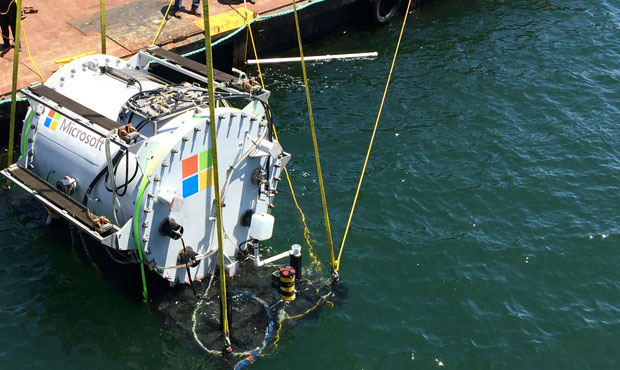Microsoft on Monday unveiledProject Natick, a research initiative aimed at developing underwater data centers that could be built near coastal cities.
The project is still in its infancy, but Microsoft built one test facility last year.
Dubbed “Leona Philpot” — after a character in the Halo video game series — it was deployed 30 feet underwater off the California coast in August and was tested through December, when it was returned to the Microsoft campus in Redmond, Washington.
Project Natick conducted the test to determine the viability of future underwater data centers, which eventually could run for 20 years or more without onsite support staff.
The project’s roots go back to 2013 when Microsoft employee Sean James submitted a ThinkWeek paper proposing the concept. James, who had served on a U.S. Navy submarine, highlighted the benefits of placing computers and even entire data centers underwater.
Project Natick kicked off a year later, and testing began last summer.
Undersea Cloud Computing
Data centers are a key component of cloud computing, a concept that evokes images of the sky. Microsoft’s Project Natick highlights the benefits that being underwater could bring.
Such facilities could be powered by renewable energy sources, including wave and tidal power, Microsoft noted.
As with underground facilities, underwater centers could be easier to cool, making them cheaper to operate as well.
“The ambient temp around these data centers is much lower below the surface of the ocean than on land, so the cost of cooling the heat-producing equipment is virtually nil,” saidFrederick Lane, an industry consultant for emerging technologies.
“Water is a far more efficient cooling medium than air,” Charles King, principal analyst at Pund-IT, pointed out.
“Temperature regulation is obviously a critical factor,” he told TechNewsWorld.
Added Security and Reliability
While no data center is completely safe from cyberattacks — especially as the point of such a facility is to ensure connectivity to the outside world — an underwater data center could have security and reliability benefits.
“Arguably, storing servers underwater would reduce the threats of terrorism or other physical attacks,” Lane told TechNewsWorld.
An added benefit is being out of direct sunlight.
“Water is excellent protection for cosmic rays, which damage computer memory and can cause systems to crash or lose accuracy,” said Rob Enderle, principal analyst at the Enderle Group.
“Placing a data center under the water should result in higher reliability and accuracy,” he told TechNewsWorld. “Particularly as we move to artificial intelligence, this water shielding could massively reduce the chance of catastrophic failure and an AI that is a tad crazy.”
Data and Population Centers
Another benefit of an underwater facility is that it could tap into unused real estate, especially given the proximity of many population centers to oceans.
“It turns out that a pretty significant chunk of the world’s population — 50 percent or so — lives within shouting distance of an ocean,” said Lane. “This model gives Microsoft the ability to put large quantities of relevant data closer to the people who actually use it, which improves response time.”
It also could reduce the cost of building materials and cut construction time.
“Submerging portable, self-contained data centers also reduces or eliminates the need for purchasing the land and developing the infrastructure necessary to support land-based facilities,” said Enderle.
Underwater data centers could offer a range of efficiencies unavailable to buildings that need facilities for human operators.
“These are relatively small, oil-barrel-sized server containers that can be built and deployed within three to four months,” said Lane. “It is a model that gives Microsoft much more flexibility.”





















































